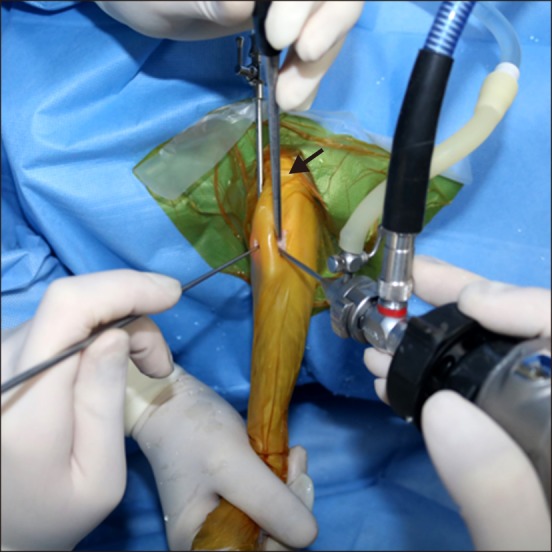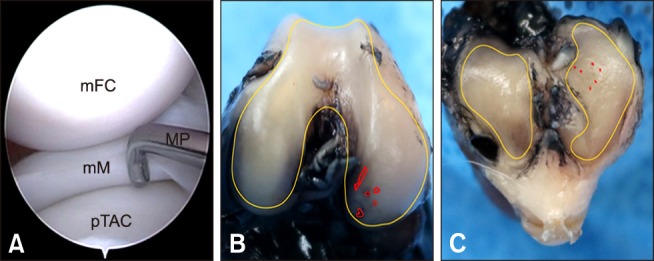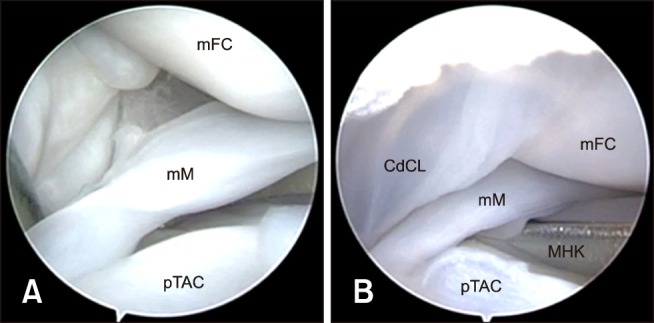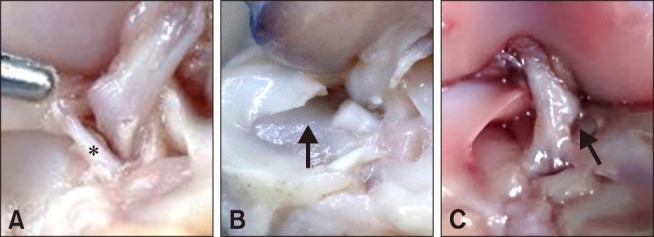J Vet Sci.
2018 Sep;19(5):693-698. 10.4142/jvs.2018.19.5.693.
Evaluation of an arthroscopic stifle lever for stifle joint distraction in toy breed dogs
- Affiliations
-
- 1College of Veterinary Medicine, Chungnam National University, Daejeon 34134, Korea. seatiger76@cnu.ac.kr
- KMID: 2420939
- DOI: http://doi.org/10.4142/jvs.2018.19.5.693
Abstract
- Arthroscopy has become an attractive modality in the diagnosis and treatment of joint diseases in toy breed dogs. However, the application of arthroscopy is limited by small joint space. Our objective was to evaluate the efficacy of a stifle lever for joint distraction during stifle arthroscopy in toy breed dogs. Paired stifles (n = 32 each) collected from 16 cadavers of toy breed dogs were randomly assigned to one of two groups: the stifle lever group or the external manipulation group. All stifles underwent arthroscopic cranial cruciate ligament transection, and the visualization of the medial meniscus was evaluated. Medial meniscal release (MMR) was then performed. Following arthroscopic examination, the success rates of MMR and damages of tibial and femoral cartilages were evaluated. Visualization of the medial meniscus was significantly better, and meniscal probing was significantly easier, in the stifle lever group than in the external manipulation group (p = 0.001). There were no significant differences between groups for MMR success or articular cartilage damage. Using the stifle lever on arthroscopic examination improved visualization and probing on the medial meniscus in toy breed dogs. The stifle lever can be used as a good modality in assessing medial meniscal pathology in toy breed dogs.
Keyword
MeSH Terms
Figure
Reference
-
1. Beale BS, Hulse DA. Arthroscopy versus arthrotomy for surgical treatment. In : Muir P, editor. Advances in the Canine Cranial Cruciate Ligament. 1st ed. Ames: Wiley-Blackwell;2010. p. 145–158. .2. Böttcher P, Winkels P, Oechtering G. A novel pin distraction device for arthroscopic assessment of the medial meniscus in dogs. Vet Surg. 2009; 38:595–600. PMID: 19573060.3. Case JB, Hulse D, Kerwin SC, Peycke LE. Meniscal injury following initial cranial cruciate ligament stabilization surgery in 26 dogs (29 stifles). Vet Comp Orthop Traumatol. 2008; 21:365–367. PMID: 18704244.
Article4. Cha JG, Lee HB, Cheong HY, Heo SY, Ragetly GR. Evaluation of a Veress needle for the fluid egress system of stifle arthroscopy in toy dog breeds. Vet Comp Orthop Traumatol. 2016; 29:149–155. PMID: 26846402.
Article5. Gemmill TJ, Farrell M. Evaluation of a joint distractor to facilitate arthroscopy of the canine stifle. Vet Surg. 2009; 38:588–594. PMID: 19573059.
Article6. Innes JF, Bacon D, Lynch C, Pollard A. Long-term outcome of surgery for dogs with cranial cruciate ligament deficiency. Vet Rec. 2000; 147:325–328. PMID: 11058021.
Article7. Kim K, Lee H, Ragetly GR. Feasibility of stifle medial meniscal release in toy breed dogs with and without a joint distractor. Vet Surg. 2016; 45:636–641. PMID: 27357273.
Article8. Luther JK, Cook CR, Cook JL. Meniscal release in cruciate ligament intact stifles causes lameness and medial compartment cartilage pathology in dogs 12 weeks postoperatively. Vet Surg. 2009; 38:520–529. PMID: 19538675.
Article9. Mahn MM, Cook JL, Cook CR, Balke MT. Arthroscopic verification of ultrasonographic diagnosis of meniscal pathology in dogs. Vet Surg. 2005; 34:318–323. PMID: 16212585.
Article10. McKee WM, Cook JL. The stifle. In : Houlton JEF, Cook JL, Innes JF, Langley-Hobbs SJ, editors. BSAVA Manual of Canine and Feline Musculoskeletal Disorders. 1st ed. Gloucester: Wiley;2006. p. 350–395.11. Pozzi A, Hildreth BE 3rd, Rajala-Schultz PJ. Comparison of arthroscopy and arthrotomy for diagnosis of medial meniscal pathology: an ex vivo study. Vet Surg. 2008; 37:749–755. PMID: 19121170.
Article12. Ralphs SC, Whitney WO. Arthroscopic evaluation of menisci in dogs with cranial cruciate ligament injuries: 100 cases (1999–2000). J Am Vet Med Assoc. 2002; 221:1601–1604. PMID: 12479333.
Article13. Whitney WO. Arthroscopically assisted surgery of the stifle joint. In : Beale BS, Hulse DA, Schulz KS, Whitney WO, editors. Small Animal Arthroscopy. 1st ed. Philadelphia: Saunders;2003. p. 137–140.
- Full Text Links
- Actions
-
Cited
- CITED
-
- Close
- Share
- Similar articles
-
- Arthroscopic detection of medial meniscal injury with the use of a joint distractor in small-breed dogs
- Biceps femoris muscle transposition for treatment of cranial cruciate ligament rupture in small breed dogs
- Establishment of an image evaluation grading criteria for experimental stifle joint osteoarthritis in dogs: an X‑ray and CT imaging study
- Intra-articular replacement of a ruptured cranial cruciate ligament using the Mini-TightRope in the dog: a preliminary study
- Gait analysis in clinically healthy small to toy breed dogs using a pressure plate





